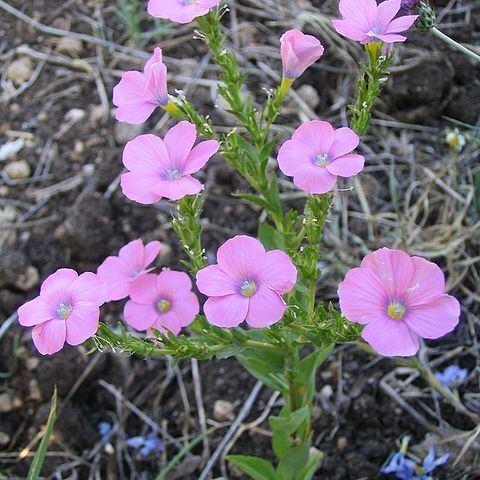Herbs or subshrubs [shrubs, trees, vines], annual, biennial, or perennial. Leaves alternate, opposite, or whorled, simple; stipules absent or present as small, dark, spheric glands; petiole usually absent, rarely present; blade margins entire, serrate, or denticulate; venation pinnate. Inflorescences terminal, racemes, panicles, or cymes (rarely thyrses or corymbs in Linum) [spikes]. Flowers bisexual; perianth and androecium hypogynous; hypanthium absent; sepals 4–5, connate basally [distinct]; petals 4–5, distinct or coherent basally, imbricate or convolute, bases sometimes with appendages; nectary extrastaminal; stamens 4–5 [10], connate basally, filament tube and petal bases adherent or adnate [free]; anthers dehiscing by longitudinal slits; pistil 1, 2–5-carpellate, ovary superior, 4–5-locular, placentation axile or apical-axile; ovules 2 per locule, anatropous; styles 2–5, distinct or partly connate; stigmas 2–5. Fruits capsules, dehiscence septicidal, or indehiscent or schizocarps breaking into 4 nutlets (Sclerolinon). Seeds 2 per locule, seed coat often mucilaginous.
Herbs or shrubs. Stipules small or absent. Leaves alternate or rarely opposite, simple; leaf blade margin entire. Inflorescences cymes or racemes. Flowers bisexual, regular. Sepals (4 or)5, distinct or basally connate, imbricate, persistent. Petals as many as and alternate with sepals, distinct or basally connate, convolute, basally often clawed, with 2-5 extrastaminal nectary glands or a disk. Stamens (4 or)5 or 10(or 15), in 1 whorl, alternate or opposite sepals, often some reduced to staminodes; filament bases connate into a tube. Ovary superior, with 2-5 carpels or seemingly 4-10-loculed by intrusion of a false septum, with 1 or 2 ovules per locule, placentation axile; styles as many as carpels, filiform, distinct or basally connate; stigmas subcapitate. Fruit usually a septicidal capsule or a drupe. Seeds with straight oily embryo and thin endosperm.
Trees, shrubs, lianes or herbs. Leaves simple, alternate or opposite; stipules present, rarely absent, divided, entire or gland-like. Inflorescence a terminal or axillary cyme, rarely flowers solitary. Flowers regular, hermaphrodite, hypogynous. Sepals 4–5, imbricate, free or partially united. Petals 4–5, contorted in bud, free or partially united at base, often clawed. Stamens 1–3 times as many as sepals; filaments united at base; staminodes sometimes present. Ovary superior, 2–5-locular; each loculus often subdivided by a false septum. Ovules pendulous, 2 per loculus. Styles 2–5, free or united at base. Fruit a capsule or drupe. Seeds with or without endosperm; embryo straight or slightly curved
Ovary superior, with 2–5 2-ovulate loculi sometimes subdivided nearly to the placentae or alternating with an equal number of empty loculi; ovules collateral, pendulous; styles free or united at the base, slender, with simple capitate or clavate stigmas
Stamens twice (rarely three times) as many as the petals, or with the antipetalous whorl staminodial or absent; filaments ± united in the lower part, sometimes glandular at the base; anthers introrse, dorsifixed, dehiscing longitudinally
Fruit a capsule dehiscing septicidally into (4) 5 2-seeded valves, or septicidally and loculicidally into (8) 10 1-seeded valves, or a drupe usually with fewer seeds than the 2–5 originally fertile loculi
Stamens as many as and alternate with the petals, sometimes alternating with small staminodes; filaments connate at base; anthers introrse, 2-celled, opening lengthwise
Ovary superior, 3–5-celled, cells often again partially subdivided; ovules 2 in each cell, pendulous; styles 3–5, free or partly united, with simple capitate stigmas
Leaves alternate or opposite, simple, penninerved or 1-nerved; stipules divided or entire or gland-like, deciduous (rarely absent)
Seeds ± compressed, shining, exarillate, with or without endosperm; embryo straight or slightly curved, with flat cotyledons
Trees, shrubs, lianes or herbs, often with tendrils on climbing shoots, glabrous or with an indumentum of simple hairs
Flowers in terminal or axillary cymes (or rarely solitary), actinomorphic, bisexual, usually heterostylic
Petals (4) 5, contorted in bud, free or very rarely united at the base, often unguiculate, fugacious
Leaves simple, alternate or opposite; stipules present or absent, sometimes gland-like
Seeds compressed, shining, with or without endosperm; embryo straight, cotyledons flat
Trees, shrubs, rarely herbs; branches sometimes climbing by hooks
Sepals (4) 5, imbricate, free or partially united
Sepals 4–5, free or partly united, imbricate
Flowers actinomorphic, hermaphrodite
Petals free, contorted, fugacious
Fruit a septicidal capsule

